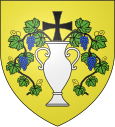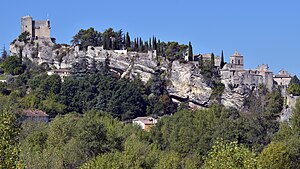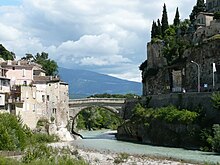Vaison-la-Romaine
| Vaison-la-Romaine | ||
|---|---|---|

|
|
|
| region | Provence-Alpes-Cote d'Azur | |
| Department | Vaucluse | |
| Arrondissement | Carpentras | |
| Canton | Vaison-la-Romaine (main town) | |
| Community association | Vaison Ventoux | |
| Coordinates | 44 ° 14 ' N , 5 ° 5' E | |
| height | 156-493 m | |
| surface | 26.99 km 2 | |
| Residents | 5,999 (January 1, 2017) | |
| Population density | 222 inhabitants / km 2 | |
| Post Code | 84110 | |
| INSEE code | 84137 | |
| Website | http://www.vaison-la-romaine.com | |
 View of the old town and castle |
||
Vaison-la-Romaine is a commune in the Vaucluse department in the region of Provence-Alpes-Cote d'Azur . It is the capital of the canton of the same name Vaison-la-Romaine in the Carpentras arrondissement . Vaison-la-Romaine has 5,999 inhabitants (as of January 1, 2017) and is located on the banks of the Ouvèze and at an intersection of ancient Roman roads . In 1924 the community added the attribute la Romaine (= the Roman). Her Roman name is Vasio Vocontiorum . After the 4th century it was temporarily a bishopric.
history
The region was inhabited by Celto- Ligurians who introduced the bronze . For centuries, the Celtic inhabitants of Vaison, the Vocontier people , moved between the two banks of the Ouvèze. Their first oppidum was a festival on the hilltop, which was their regional capital. After the Roman conquest in the 2nd century BC The Celtic inhabitants settled next to the invaders in the fertile plains on the other side of the Ouvèze.
The Romans upgraded the city of their treaty and alliance partners, which was then equipped with villas, theaters, baths, aqueduct and bridge and grew to around 10,000 inhabitants. Vasio belonged to the Roman province of Gallia Narbonensis . From her came the Praetorian prefect Sextus Afranius Burrus and - according to a hypothesis that cannot be clearly verified - the historian Cornelius Tacitus .
Meanwhile, Christianity had in the city next to the Mithras and Kybelekult spread and eventually more and more enforced. At the end of the 3rd century there was a Christian community and a first bishop . Though many peoples ruled the city over the centuries, the real power came from the church. In 1160 the Counts of Toulouse conquered the city, where it was badly damaged. Count Raymond VI. von Toulouse built a medieval castle on the rocky slope above the city in place of the Celtic festivals, the security of which attracted residents to the Haute Ville . In the 14th century Vaison came into the possession of the Comtat Venaissin , the papal property to which it belonged until the French Revolution .
More recently, Vaison-la-Romaine hit the headlines when on September 22, 1992, 35 fatalities occurred in a flood, hundreds of homes were destroyed and the damage to property was estimated at approximately five billion French francs. A detailed description of the dramatic circumstances, the causes and the consequences can be found on the official website of the municipality. Following this event, a new bank design on the Ouvèze was tackled.
Attractions
Roman excavations
Vaison-la-Romaine is the largest French archaeological site. The archaeological remains that can be viewed today date from the 1st and 2nd centuries AD.
Due to the size of the public buildings, as far as they could be excavated, it can be concluded that the city had an area of around 60 to 70 hectares in Roman times. The amphitheater was carved into the northern slope of the rock of Puymim Hill and offered around 5,000 to 6,000 spectators.
In the east of Vaison, a temple was built in Augustan times . Large gardens with columns surround it. This was a public place for religious ceremonies. Remains of various thermal baths can be visited in various places in the area, including in the east of the cobbled street (Villasse), on the south bank of the Ouvèze, the more famous baths in the north from the middle of the first century on 2,000 m². The oldest baths take up an area of 2,300 m² and are located in the Maison du Buste d'Argent , a house named after the silver bust of the client found in it. The villa had mosaic floors and two gardens with water basins. The neighboring Maison du Dauphin was also equipped with gardens and pools. The heart of the Roman city - forum and basilica - is covered by the modern city and has therefore not been excavated. But at least a fifth of the Roman city - 13 hectares - has been exposed and can be entered from the Place Abbé Sautel.
The 17 m wide Roman bridge over the Ouvèze is one of the most important bridges in the province of Narbonne and one of the very rare ancient bridges that is still in use today. It played a strategic role as the only crossing of the Ouvèze. In the time of the Counts of Toulouse it was used as a customs bridge , which was protected by a defensive gate to the upper town. In the 15th century it was used as a control and watch post.
In the archaeological museum on the other side of Puymin Hill - the most visited of its kind in the region with 60,000 to 65,000 admissions - a variety of objects and inscriptions that were discovered during the excavations can be admired and everyday life in Roman times in a provincial town be better understood. These include the model of the amphitheater and the Maison du Dauphin , as well as everyday objects, frescoes and mosaics that were found in the Villa du Paon and give an impression of the interior decorations of that era.
- Discovery story
In the 19th century, most of Vaison's residents settled on the left bank and left the upper town to decay. During their reconstruction, parts of the Roman city center were exposed. But it was not until 1908 that the first serious excavations began by Abbé Sautel.
More Attractions
Notre-Dame de Nazareth
The cathedral stands on the edge of the Roman excavations on the foundations of an ancient temple , some column drums of which are built into the foundation walls of the choir . A Roman double column with a Corinthian capital has also been preserved on the west side . The building history can be "read" from the substance of the church walls. Only small rubble stones were used in the area of the apses and at the base of the nave walls , which suggests that construction began in the 11th century. When better processed ashlar stones were used in Provence in the 12th century , the building could be increased to its present shape. However, this measure changed the structural engineering , which made it necessary to subsequently add buttresses to support the arch support . The three-aisled basilica without a transept is typical of the Romanesque type of church in Provence. However, the last yoke in front of the choir has an eight-sided dome , as is usual when there is a crossing . The vestibules are rather inside frühchristlich and early Romanesque established: among the later-inserted, Gothic choir window a stone Bishop Throne is incorporated into the chorus round, in the northern side vestibule is an altar of carved marble with early Christian reliefs and the chorus wall pre-blanked pillars carry Corinth capitals.
A door in the north aisle leads into the cloister , which looks quite uniform, although destroyed columns had to be replaced during its renovation in the 19th century. The round-arched barrel and ridge vaults are supported by corner pillars, between which two double columns stand on common plinths . Each of the columns is equipped with its own capital pattern. The cloister now serves as a small museum, in which sculptures , building fragments and inscriptions from early Christian and medieval times can be seen. This includes a part of a marble sarcophagus , on which apostles dressed in a relief can be seen, and a double-sided crucifix from the 15th century. An inscription in Leonine verse on the north side of the cathedral confirms the cloister as an image of the heavenly order and is at the same time an encrypted message that imposes a rule of conduct on the canons :
- OBSECRO VOS FRATRES AQUILONIS VINCITE PARTES
- SECTANTES CLAUSTRUM QUIA SIC VENIETIS AD AUSTRUM
- TRIFIDA QUADRIFIDUM MEMORET SUCCENDERE NIDUM
- IGNEA BISSENIS LAPIDUM SIT UT ADDITA VENIS
- PAX HUIC DOMUI
When walking through the cloister, one should choose the path so that it leads from the north (according to the medieval view the seat of evil) to the south, the direction of promise and salvation.
Saint-Quenin
Quenin was bishop of Vaison-la-Romaine in the 6th century and was venerated as a saint soon after his death. The chapel dedicated to him stands about 600 meters northwest of the city center and is an example of the Provencal Romanesque style, inspired by antiquity. During the construction of the eastern part in the 12th century, Roman building materials were partially used. The unusual choir has a triangular floor plan. The half-columns at the corners are fluted and have Corinthian capitals. Above the capital in the northeast corner, friezes depict the sacrifice of Abraham and Hercules with the lion. The western part of the church was renovated between 1630 and 1636 in the Romanesque style. A bas-relief from Merovingian times with vines, a chalice and a Greek cross was inserted into the west wall above the entrance .
Inside, the single-nave nave runs over three bays and ends in a pentagonal main apse and two sloping, semicircular side apses.
Upper town
The medieval town, which had fallen into disrepair, is surrounded by a rampart . The town gate dates from the 14th century. Many residential and manor houses from the 16th to 18th centuries, squares, fountains, as well as the former bishop's church from 1464, have now been renovated. On the hill above are the remains of the castle , which the Counts of Toulouse had built at the end of the 12th century and which was heavily modified in the 14th, 15th and 16th centuries.
The small mountain range of Dentelles de Montmirail begins south of Vaison-la-Romaine
Festivals
The international choir festival « Les Choralies » of the organization «A Coeur Joie» is held every three years . Choirs from all over France and guest choirs from all over the world meet for 12 days at the beginning of August to present their repertoires to each other (“Petits Concerts”) and to study and perform great works of choral literature in workshops (“Ateliers”) under well-known conductors. The highlight of the shared experience is the “Chant Commun”, the singing of all (up to 7000) participants, always before the evening studio concerts in the open air in the Roman amphitheater. The 22nd festival took place in 2016.
Every summer in the month of July, the dance festival "Vaison Danses" takes place, where ensembles from the international dance scene perform in the amphitheater.
Markets
Every Tuesday is market day ( grand marché provençal ). The large and steadily growing market with many Provencal products attracts countless tourists from all over the area, especially in the summer months. Duration: from around 9:00 a.m. to 1:00 p.m.
Town twinning
The city has signed a partnership with Martigny in the Swiss canton of Valais .
literature
- Thorsten Droste: Romanesque Art in France . DuMont Buchverlag Cologne 1989, pp. 112-114, ISBN 3-7701-2009-4 .
- Marianne Mehling: Provence and the Côte d'Azur . Weltbild-Verlag Augsburg 1998, pp. 234-238, ISBN 3-8289-0692-3 .
See also
Web links
- Website of the city of Vaison-la-Romaine
- Historical recordings of Notre-Dame de Nazareth
- Les Choralies















